BIO 13 WEEKLY SPECIES ID
1/34
There's no tags or description
Looks like no tags are added yet.
Name | Mastery | Learn | Test | Matching | Spaced |
|---|
No study sessions yet.
35 Terms
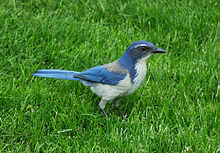
California Scrub Jay
native to California
blue head, wings, and tail, necklace
gray-brown back
grayish underparts
white eyebrows and throat
call or "screech" is described as "harsh and scratchy"
inhabits areas of low scrub, preferring pinon-juniper forests, oak woods, and edges of mixed evergreen forests
feed on small animals, such as frogs and lizards, eggs and young of other birds, insects, and (particularly in winter) grains, nuts, and berries
life span ~9 years
adversely affected by the West Nile virus
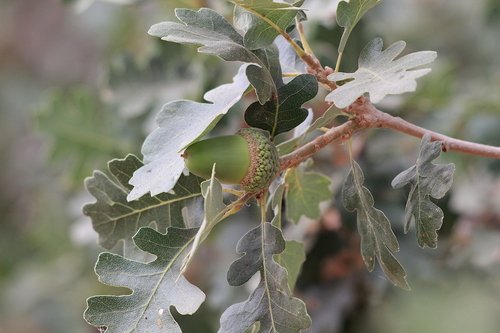
Quercus lobata (Valley Oak)
native to California
found in dense riparian forests, open foothill woodlands, and valley savannas
live up to 600 years
may surpass 30 meters (98 feet) in height
thick, ridged bark
lobed leaves
deciduous, requires year-round ground water
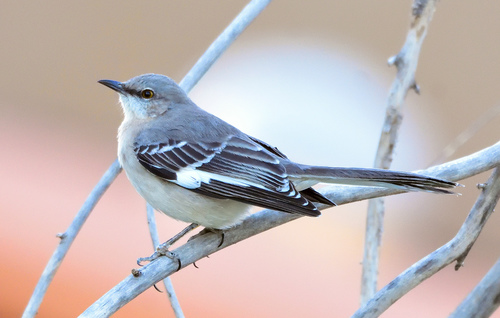
Northern Mockingbird
upper parts are colored gray
underparts have a white or whitish-gray color
iris is usually a light green-yellow or a yellow
bill is black with a brownish black appearance at the base
measure from 20.5 to 28 cm
lifespan is observed to be up to 8 years, but captive birds can live up to 20 years
in the eastern regions, suburban and urban areas such as parks and gardens are frequent residential areas
In western regions, desert scrub and chaparral are among its preferred habitats
diet consists of arthropods (such as spiders, grasshoppers, wasps, bees, ants, beetles, butterflies, and caterpillars), earthworms, berries, fruits, seeds, and occasionally flowers, small crustaceans, and lizards
imitate the vocalizations of other birds
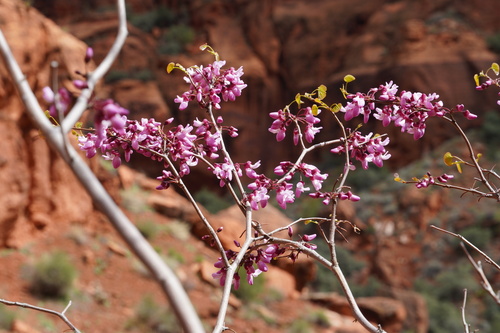
Cercis occidentalis (Western Redbud)
a deciduous shrub to small tree, growing up to 7 metres
leaves are arranged alternately along the twigs and are simple, round, and slightly leathery, growing to 5–9 centimetres
leave have heart shaped bases
bright pink or magenta flowers
abundant seeder and seeds have a high rate of germination
wood is fine-grained, dark yellowish brown, with a thin layer of whitish sapwood.
native habitats include foothill woodlands and chaparrals; they grow near stream banks in dry foothills and lower canyon slopes below 1,100 metres
leaves are harvested by native leafcutter bees and the flowers are an important nectar and pollen source for native insects and hummingbirds.
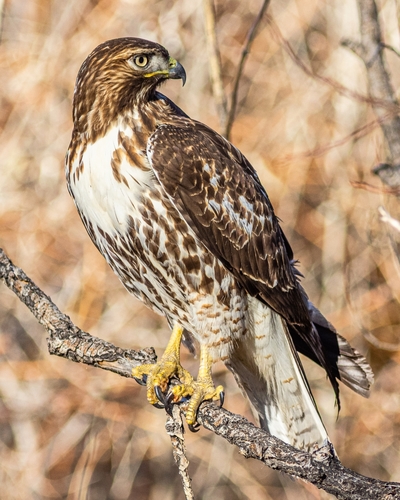
Red-tailed Hawk
breeds throughout most of North America
occupies a wide range of habitats and altitudes, including deserts, grasslands, coniferous and deciduous forests, agricultural fields, and urban areas.
favors varied habitats with open woodland, woodland edge and open terrain
is legally protected in Canada, Mexico, and the United States by the Migratory Bird Treaty Act
14 recognized subspecies
whitish underbelly with a dark brown band across the belly, formed by horizontal streaks in feather patterning, is present in most color variations
most adult red-tails have a dark-brown nape and upper head, which gives them a somewhat hooded appearance, while the throat can variably present a lighter brown "necklace"
red-tail
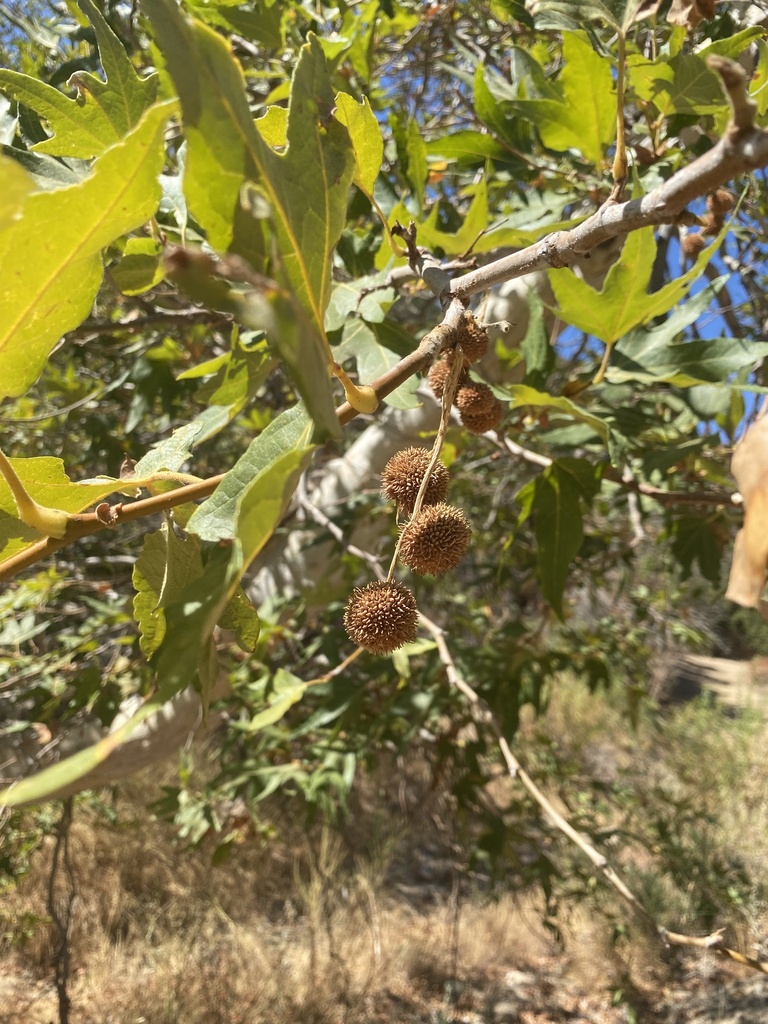
Platanus racemosa (Western Sycamore)
native to California and Baja California
grows in riparian areas, canyons, floodplains, at springs and seeps, and along streams and rivers in several types of habitats.
grows to 35 meters
trunk generally divides into two or more large trunks splitting into many branches
bark is an attractive patchwork of white, tawny beige, pinkish gray, and pale brown
large palmately lobed leaves may be up to 25 centimetres (9.8 in) centimeters wide and have three or five pointed lobes
many small birds feed on its fruit, and several mammals eat its twigs and bark
female flower heads develop into spherical fruit clusters each made up of many hairy, maroon-red-woolly achenes
more susceptible to cross-breeding with other Platanus trees.
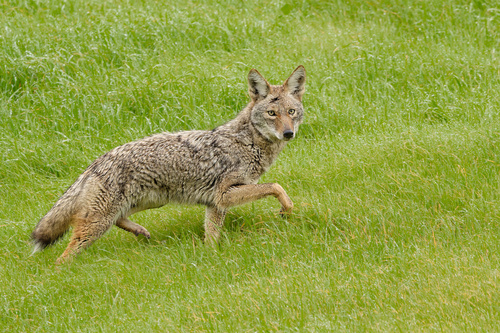
Canis latrans (Coyote)
native to North America
19 recognized subspecies
average male weighs 8 to 20 kg (18 to 44 lb) and the average female 7 to 18 kg (15 to 40 lb)
fur color is predominantly light gray and red or fulvous interspersed with black and white
diet consists mainly of deer, rabbits, hares, rodents, birds, reptiles, amphibians, fish, and invertebrates
live either in a family unit or in loosely knit packs of unrelated individuals
somtimes mate with gray wolves
use a den, usually the deserted holes of other species
dens can be located in canyons, washouts, coulees, banks, rock bluffs, or level ground
communicate through howling
hunted by cougars and gray wolves

Amsinckia menziesii (Common Fiddleneck)
has a terminal flowering whorl somewhat shaped like the head of a violin or fiddle
flowers are yellow-orange, orange, or dark yellow
the favorite food of Lawrence's goldfinch during that Californian bird's nesting season of spring and early summer
native to western North America
considered a weed in Australia
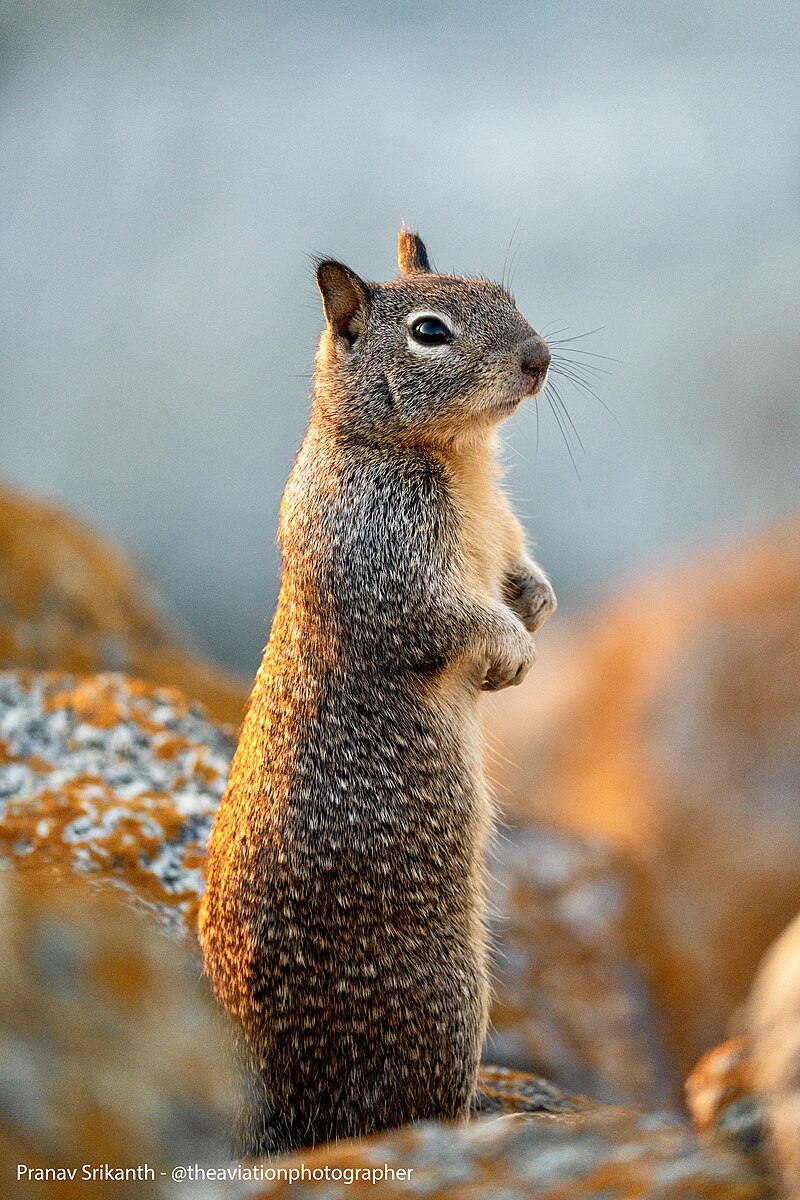
Otospermophilus beecheyi (California Ground Squirrel)
upper parts are mottled, with the fur containing a mixture of gray, light brown and dusky hairs
shoulders, neck and sides are a lighter gray
fur around the eyes is whitish
underside is lighter, buff or grayish yellow
head and body are about 30 cm (12 in) long and the tail an additional 15 centimetres (5.9 in)
can weigh from 280 to 738 g
live in burrows
commonly feed on seeds, such as oats, but also eat insects such as crickets and grasshoppers, as well as various fruits
preyed on by rattlesnakes, eagles, raccoons, foxes, badgers, and weasels
live up to six years
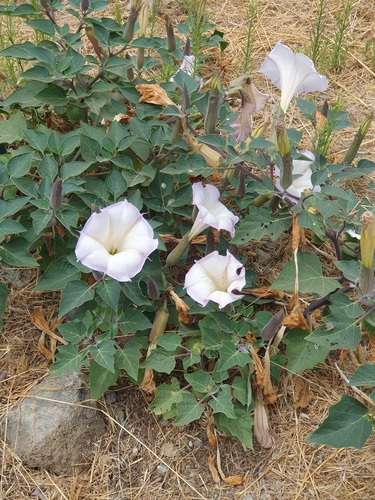
Datura wrightii (Sacred Datura)
native to the Southwestern United States and northwestern Mexico
poisonous perennial plant
used as a hallucinogen
toothed leaves
grows 30 cm to 1.5 m tall and wide
flowers are fragrant white trumpets, sometimes with a purple tint
often can be seen as a ground vine in habit, growing close to the ground and spreading in a very exposed environment with full direct sunlight
flowers open in the morning and evening and close during the heat of the day
invasive in Australia
may be fatal if ingested by humans, livestock, or pets
sacred to some Native Americans and has been used in ceremonies and rites of passage by Chumash, Tongva, and others
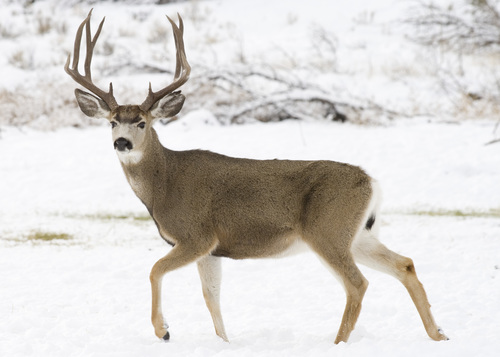
Odocoileus hemionus (Mule Deer)
indigenous to western North America
found only on the western Great Plains, in the Rocky Mountains, in the southwest United States, and on the west coast of North America
can be divided into two main groups: the mule deer and the black-tailed deer
tail is black-tipped
antlers are bifurcated; they "fork" as they grow
does not generally show marked size variation across its range
antlers fall off during the winter
predators of mule deer are coyotes, wolves, and cougars
eat forb vegetation, small amounts of grass and, where available, tree or shrub fruits such as beans, pods, nuts (including acorns), and berries.
chronic wasting disease
migrate from low elevation winter ranges to high elevation summer ranges

Bromus rubens (Red Brome)
winter annual grass, growing solitary or tufted, with erect or ascending culms growing 20–70 cm
leaf sheaths are downy or slightly hairy
pikelets vary in color from green to distinctly purplish-red
emerges in early winter and remains dormant until spring when heavy rainfall and higher temperatures stimulate growth
grow during periods of heavy rainfall, and populations can be wiped out during extended periods of drought
native to southern and western Europe
was brought to North America in 1848 and was naturalized by the 1890s.
in North America, it grows in waste areas, road verges, and disturbed areas, in both ranges primarily on dry stony or sandy soil
in its native range the grass grows in cultivated fields and steppes
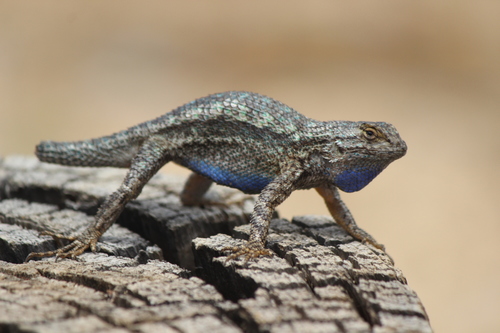
Sceloporus occidentalis (Western Fence Lizard)
native to Arizona, New Mexico, and California, as well as Idaho, Nevada, Oregon, Utah, Washington, and Northern Mexico
known as the blue-belly
brown to black in color (the brown may be sandy or greenish) and have black stripes on their backs, but their most distinguishing characteristic is their bright blue bellies
ventral sides of the limbs are yellow
male blue belly lizards also have blue patches on their throats
found in grassland, broken chaparral, sagebrush, woodland, coniferous forest, and farmland, and occupies elevations from sea level to 10,800 ft
have evolved to have shorter limbs and toes
commonly seen basking on paths, rocks, and fence posts, and other suitable sunny locations
primarily eats small invertebrates
lyme disease
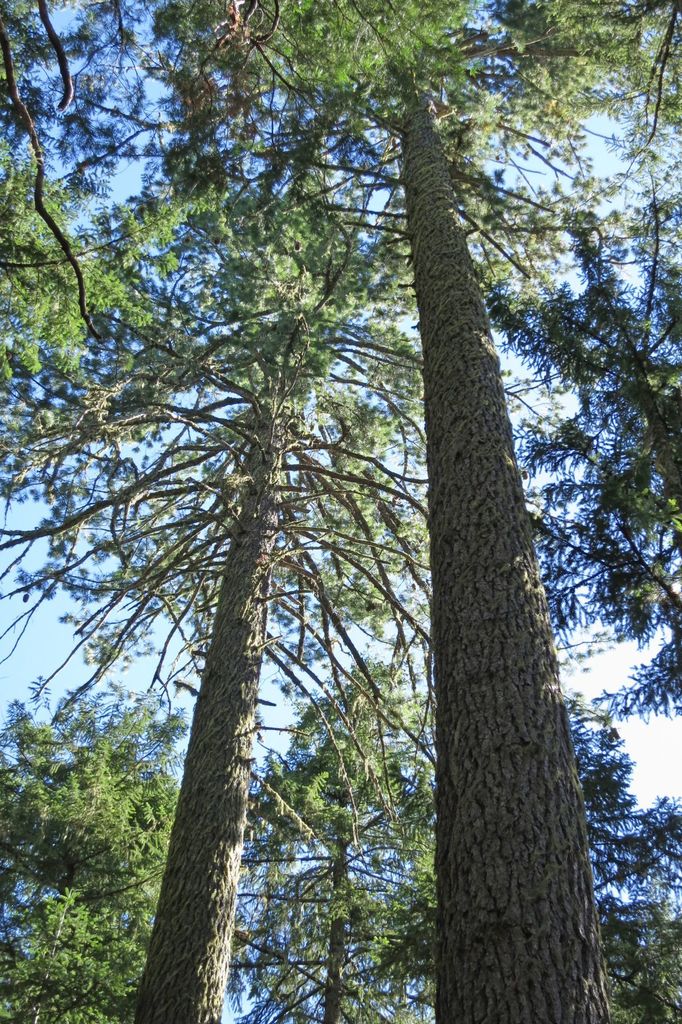
Pinus lambertiana (Sugar Pine)
tallest and most massive pine tree and has the longest cones of any conifer
native to coastal and inland mountain areas along the Pacific coast of North America, as far north as Oregon and as far south as Baja California in Mexico
40–60 meters tall
bark ranges from brown to purple in color
longest cones of any conifer, mostly 10–50 cm
never grows in pure stands, always in a mixed forest, and is shade tolerant in its youth
threatened by mountain pine beetle
tinsled leaves
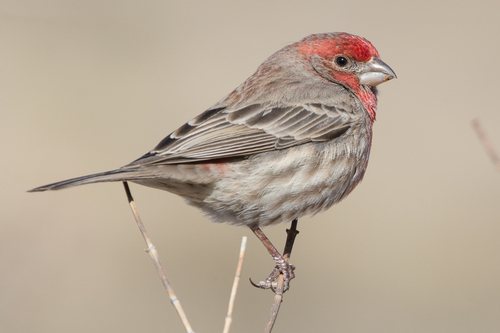
House Finch
native to Mexico and southwestern United States
square-tipped brown tail and are a brown or dull-brown color across the back with some shading into deep gray on the wing feathers
breast and belly feathers may be streaked
adult males' heads, necks and shoulders are reddish
colors range from pale straw-yellow through bright orange (both rare) to deep, intense red
songs typically consist of a series of high-pitched musical jumbles ending with a distinct high note, wheer
primarily eat grains, seeds and berries
naturalized in largely unforested land
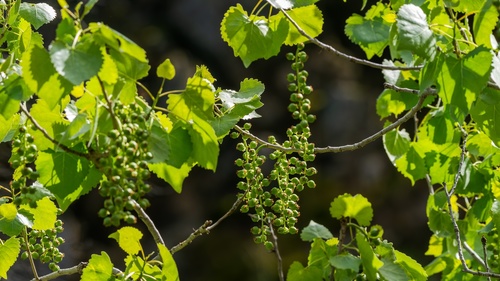
Populus fremontii (Fremont Cottonwood)
native to riparian zones of the Southwestern United States and northern through central Mexico
grows near streams, rivers, springs, seeps, wetlands, and well-watered alluvial bottomlands at elevations below 2,000 metres
long leaves, are cordate (heart-shaped) with an elongated tip, with white veins and coarse crenate teeth along the sides, glabrous to hairy, and often stained with milky resin
bark is smooth when young, becoming deeply fissured with whitish, cracked bark on old trees
long, drooping catkin, which blooms from March to April
fruit is a wind-dispersed achene, that appears to look like patches of cotton hanging from limbs, thus the name cottonwood.
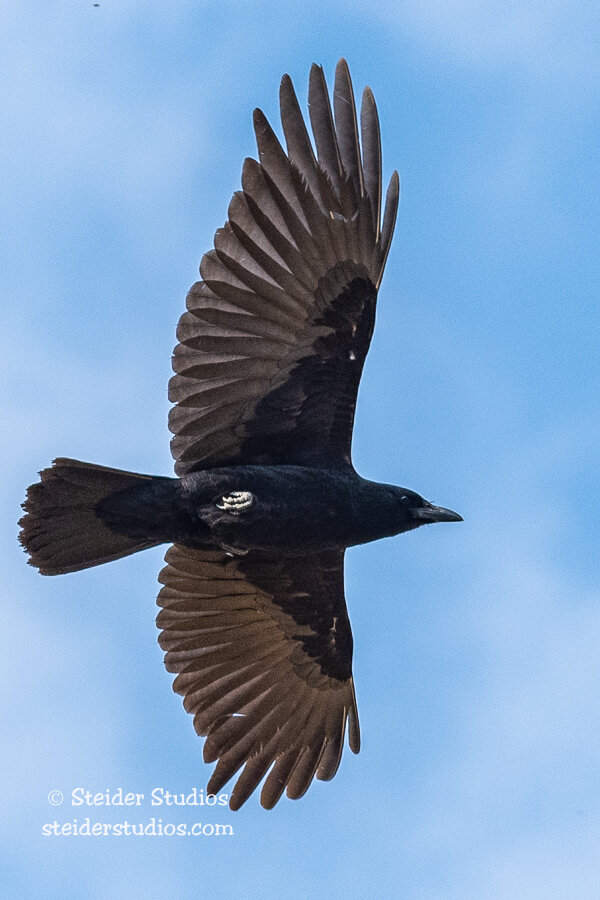
American Crow
Plumage is all black, with iridescent feathers
most usual call is CaaW!-CaaW!-CaaW
smaller and the beak is slightly less pronounced than that of a raven
can produce a wide variety of sounds and sometimes mimic noises made by other animals, including other birds, such as barred owls
absent only from tundra habitat
feed on invertebrates of all types, carrion, human food scraps, fruits, nuts such as walnuts and almonds, seeds, eggs, nestlings, stranded fish on the shore, and various grains
prey on mice, young rabbits, frogs, and other small animals
used as a motif in some human cultures, often associated with death, thieves, graveyards, bad luck, and other negative connotations
seen by some neo-pagan and indigenous cultures as signs of good luck, or even signs of certain gods, such as Apollo, Odin, and others
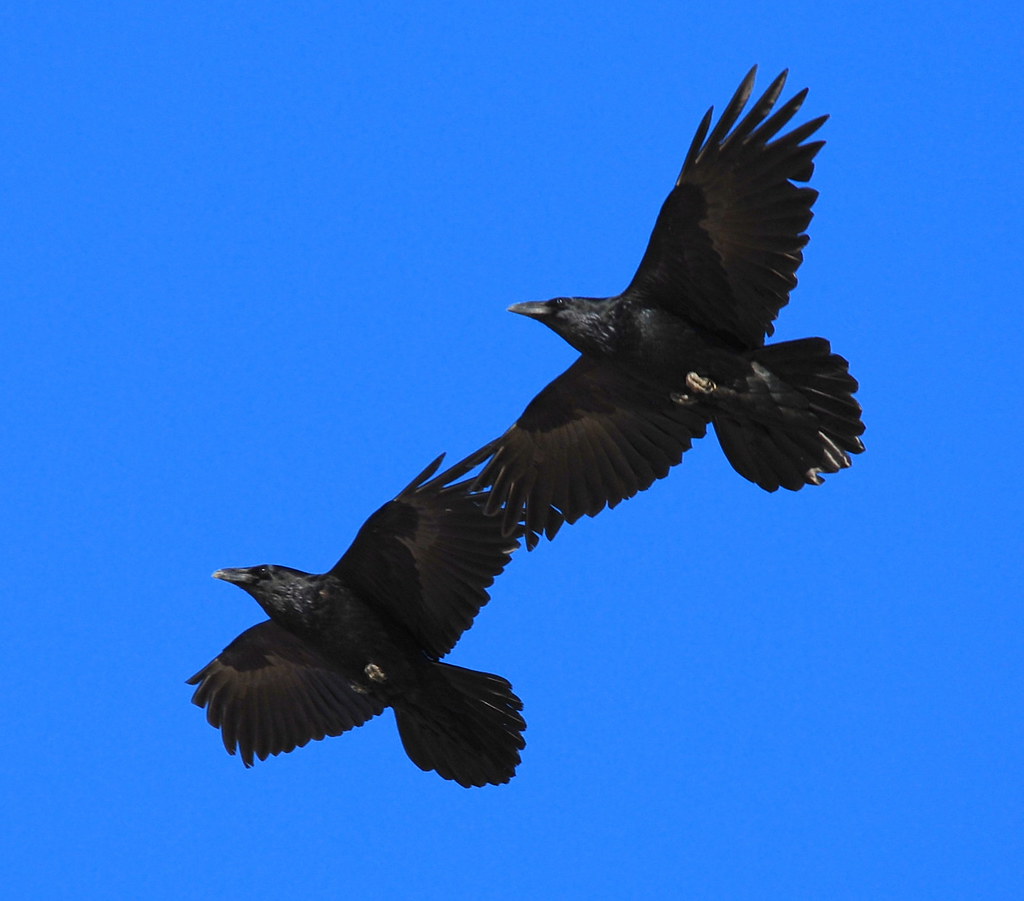
Common Raven
can live more than 23 years in the wild
one of the two largest corvids
in sunlight, the plumage can display a blue or purple sheen which is a result of iridescence
differs from related crows by having a larger and heavier black beak, shaggy feathers around the throat, longer bristles above the beak, and a longer, wedge-shaped tail
has a distinctive, deep, resonant prruk-prruk-prruk call
can mimic sounds from their environment, including human speech
prefer wooded areas with large expanses of open land nearby, or coastal regions for their nesting sites and feeding grounds
display ability in problem-solving, as well as other cognitive processes such as imitation and insight
considered to be birds of ill omen, death and evil in general
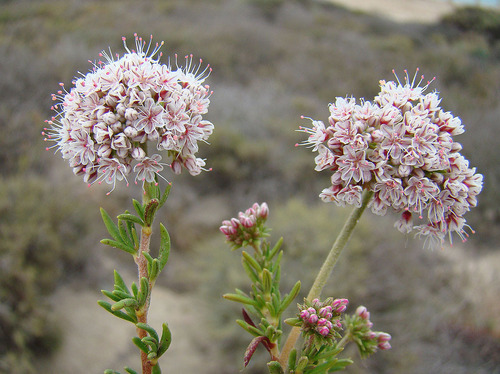
Eriogonum fasciculatum (California Buckwheat)
small, white and pink flower clusters that give off a cottony effect
grows variably from a patchy mat to a wide shrub, with the flowers turning a rusty color after blooming
provides an important food resource for a diversity of insect and mammal species
provides numerous ecosystem services for humans, including erosion control, post-fire mitigation, increases in crop yields when planted in hedgerows, and high habitat restoration value
grows on slopes and dry washes in diverse habitats, including chaparral, coastal sage scrub, grasslands, sagebrush scrub, pinyon-juniper woodland, and creosote bush scrub
used as a food crop and medicinal plant by various Native American tribes
most important native source of honey in California
Lynx rufus (Bobcat)
ranges from southern Canada through most of the contiguous United States to Oaxaca in Mexico
inhabits wooded areas, semidesert, urban edge, forest edge, and swampland environments
hunts insects, chickens, geese and other birds, small rodents, and deer, prefers rabbits and hares
marks territory via claw marks and deposits of urine or feces
spotted patterning acts as camouflage
range does not seem to be limited by human populations, but by the availability of suitable habitat
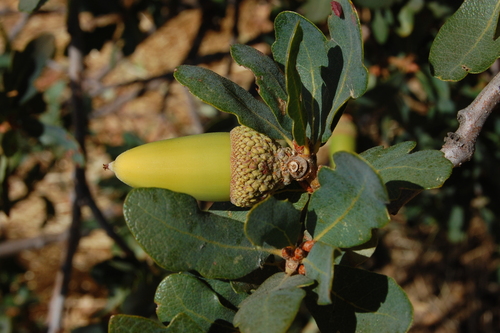
Quercus douglasii (Blue Oak)
California's most drought-tolerant deciduous oak
a dominant species in the blue oak woodland ecosystem
common in the Coast Ranges and the foothills of the Sierra Nevada
bark is light gray with many medium-sized dark cracks
blue-green leaves are tough and leathery, deciduous, and shallowly lobed
prefers dry to moist soil and plenty of sunlight
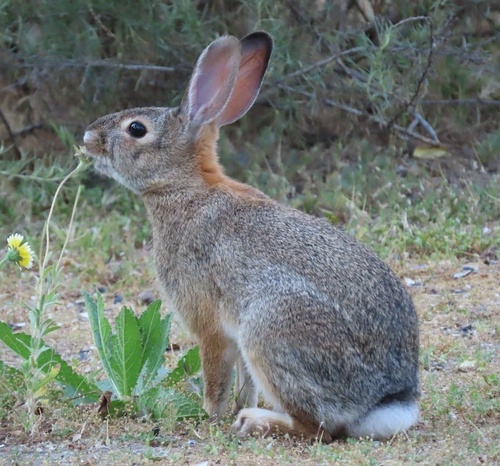
Sylvilagus audubonii (Desert Cottontail)
lifespan averages less than two years
few young survive to adulthood
social among its peers, often gathering in small groups to feed
greyish-brown, rounded tail with a broad white edge and white underside
frequently found in the riparian zones in arid regions
90% of their diet consisting of grass
feed on the leaves and peas of mesquite, barks, fallen fruit, the juicy pads of prickly pear, and twigs of shrubs
rarely needs to drink

Salix sp. (Willow)
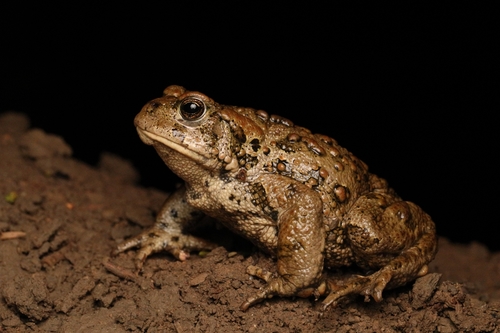
Anaxyrus boreas (Western Toad)
frequently encountered during the wet season on roads, or near water at other times
white or cream dorsal stripe, and is dusky gray or greenish dorsally with skin glands concentrated within the dark blotches
wet or dry mountain meadows or riparian deciduous forest with available open water for breeding
usually spend the daylight hours on the forest floor in the soil under rocks, logs, stumps, or other surface objects or in rodent burrows
diet consists largely of bees, beetles, ants, and arachnids

Pinus sabiniana (Gray Pine)
grow to 11–14 metres
grows at elevations between sea level and 1,200 m
found throughout the Sierra Nevada and Coast Ranges foothills that ring the Central, San Joaquin and interior valleys
needles are a food of the caterpillars of the Gelechiid moth
Some Native American groups relied heavily on sweet pine nuts for food
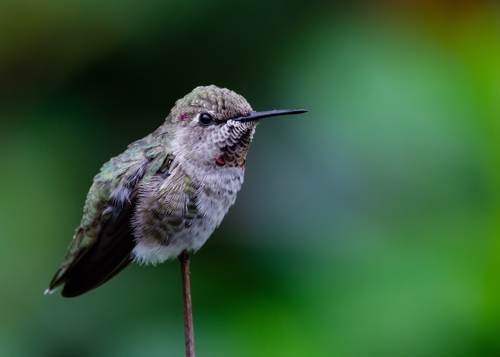
Anna’s Hummingbird
iridescent bronze-green back, a pale grey chest and belly, and green flanks
consumes tree sap, nectar from flowers, insects, and sugar-water mixes from feeders
capture flying insects or eat insects trapped in spider webs
assist in pollination
native to western coastal regions of North America
named after Anna Masséna, Duchess of Rivoli.
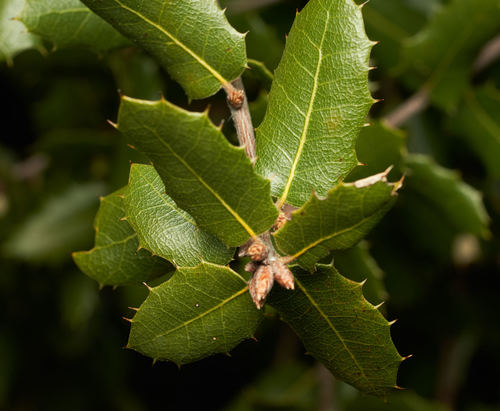
Quercus wislizenii (Interior Live Oak)
common in the low-elevation Sierra Nevada foothills
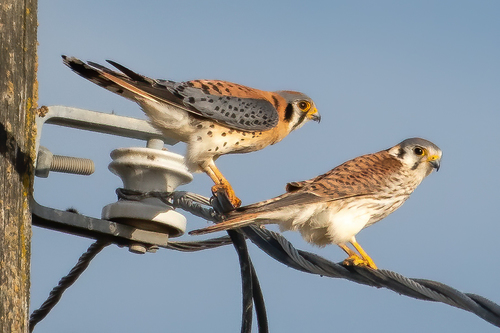
American Kestrel
smallest and most common falcon in North America
three basic vocalizations – the "klee" or "killy", the "whine", and the "chitter"
found in a wide variety of habitats, including grasslands, meadows, deserts and other open to semi-open regions
habitat must include perches, open space for hunting, and cavities for nesting
feed largely on small animals such as grasshoppers, crickets, butterflies, moths, dragonflies, beetles,[39] lizards, mice, voles, shrews, frogs, and small birds
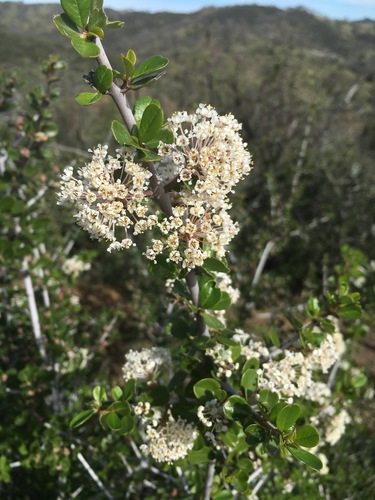
Ceanothus cuneatus (Buckbrush)
native to Oregon, California, and northern Baja California
fragrant flowers are white, sometimes tinted strongly with blue or lavender
fruit is a round capsule with horns
larval host to the California hairstreak, California tortoiseshell, ceanothus silkmoth, echo blue, hedgerow hairstreak, Pacuvius duskywing, western green hairstreak, and white-streaked saturnia moth
can be found in a number of habitats, especially chaparral
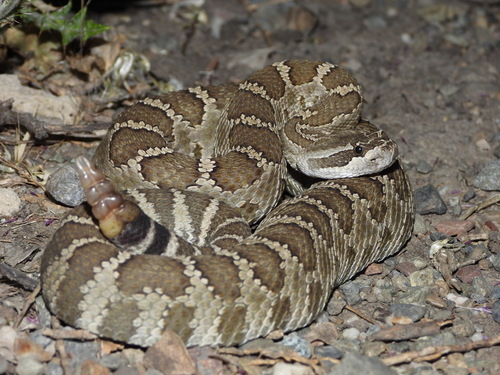
Crotalus oreganus (Western Rattlesnake)
size varies
found in western North America from the Baja California Peninsula to the southern interior of British Columbia.
eats birds, bird eggs, and small mammals, from mice to rabbits
threatened
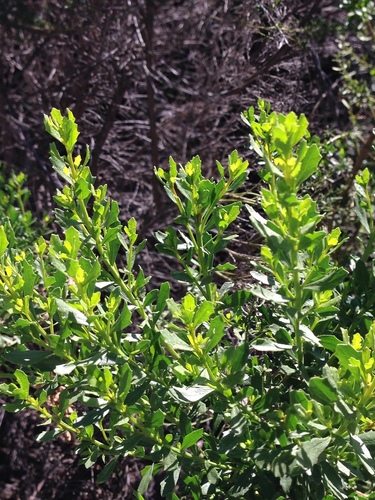
Baccharis pilularis (Coyote Brush)
native to California, Oregon, Washington, and Baja California
found in a variety of habitats, from coastal bluffs, oak woodlands, and grasslands, including on hillsides and in canyons, below 2,000 feet
displaces highly biodiverse grassland habitats that are important to carbon storage and resilient to wildfires.
used frequently in drought tolerant, native plant, and wildlife gardens, and in natural landscaping and habitat restoration projects
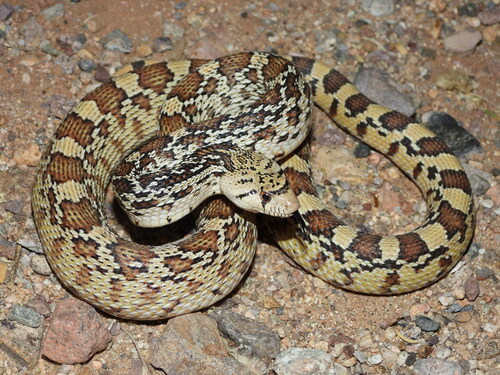
Pituophis catenifer (Gopher Snake)
nine subspecies
often mistaken for the prairie rattlesnake
yellowish or a light, sandy brown, with a series of large, dark brown or black markings and smaller, darker spots along the sides
puffs up its body and curls itself into the classic strike pose of a rattlesnake in self defense
typically live 12 to 15 years
endemic to North America
found in deserts, prairies, woodlands, brushlands, coniferous forests, and even cultivated lands
primarily feed on small mammals, including: gophers, mice, rats, ground squirrels, rabbits, and moles.
also consume other prey items such as birds and their eggs, lizards, insects, and small snakes

Aesculus californica (California Buckeye)
native to California and southwestern Oregon
often coated with lichens and mosses
grows along the central coast and in the lower elevations of the Sierra Nevada and Cascade Range
found growing in a wide range of conditions from crowded, moist, semi-shaded canyon bottoms to dry south-facing slopes and hilltops
Native American tribes, including the Pomo, Yokuts, and Luiseño, used the poisonous nuts and seeds to stupefy schools of fish in small streams to make them easier to catch
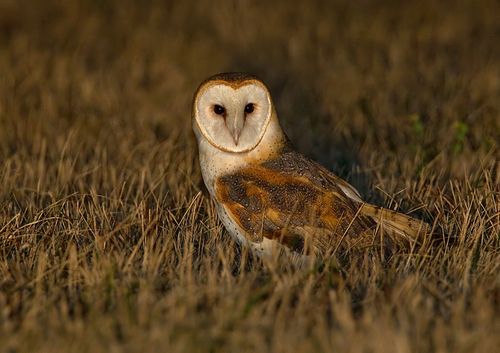
Barn Owl
native to North and South America
90% of the prey tends to be small mammals, whereas in hot, dry, unproductive areas, the proportion is lower, and a great variety of other creatures are eaten depending on local abundance
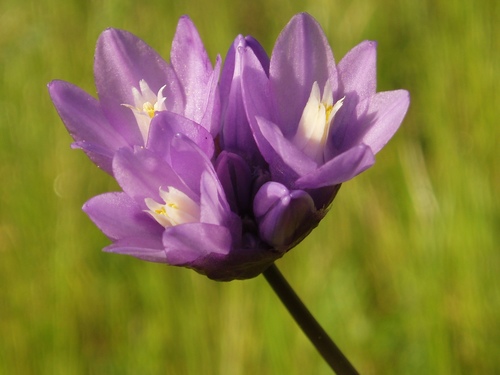
Dipterostemon capitatus (Blue Dicks)
native to the Western United States (particularly Arizona, California, Oregon, Utah, and New Mexico) and northwest Mexico
Corms are eaten by animals such as black bears, mule deer, non-native wild pigs, rabbits, and pocket gophers
inhabits a wide variety of plant communities, including vernal pools, valley grassland, scrub, coniferous forests, and open woodlands
thrive in open disturbed environments, and are a common post-fire succession species in chaparral